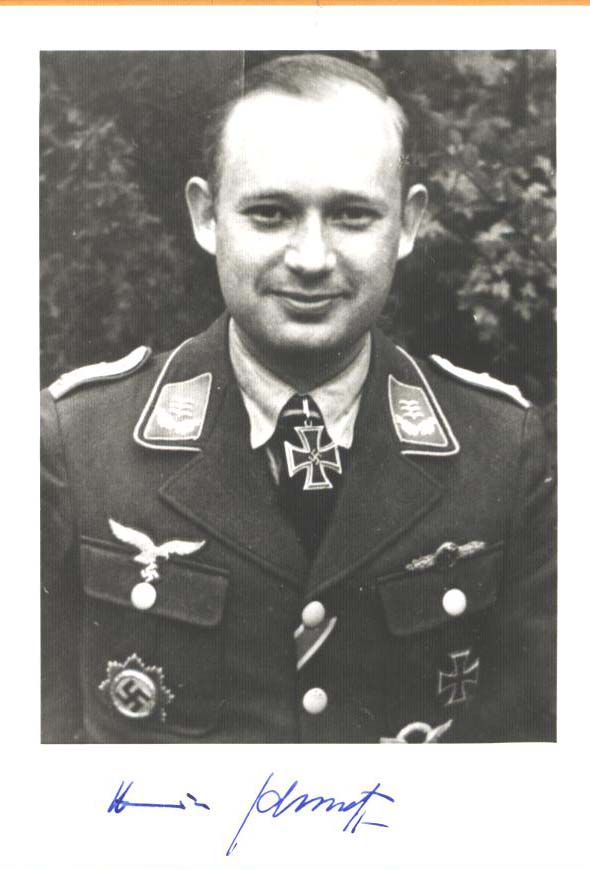
|
~SOLD~SCHMETZ Heinrich
Heinrich Schmetz was a pioneer in the testing Hand employment of precision guided munitions in World War II. After beginning his lifetime in aviation piloting gliders at age 14, Schmetz entered the Luftwaffe in 1935 and after navigator training was sent to Kampfgeschwader (KG) 253, the "General Wever" bomber wing, where he flew the Junkers 52, Dornier 23 and Junkers 86. In late 1937, he entered the reserves and resumed studies for a degree in aeronautical engineering.
A few days before the blitzkrieg into Poland, he was recalled to active service in his old wing, now re-designed KG 4. In the spring of 1940, Schmetz was assigned to 7./KG 4 and often flew missions with the Staffelkapitan, Hajo Herrmann, first in the Heinkel 111 and later in the Junkers 88. He participated in the attack on France and the Low Countries and then in Operation Weserubung, the campaign into Denmark and Norway. During the Battle of Britain, Schmetz flew night missions against British industrial complexes and coastal shipping. When his bomber unit moved to Sicily, he saw action from Gibraltar to Greece. On a spectacular night attack on Piraeus harbor, Schmetz scored a direct hit on the British ammunition ship Clan Frazier.
The explosion sank eleven ships and devastated the port. In late 1941, he returned to the Western Front to fly reconnaissance over the North Sea and English Channel. In 1942, this skilled navigator went to pilot training. After earning his pilot's badge, he was moved to a unit testing radio-controlled bombs, the first effective guided munitions. In 1943, Schmetz was assigned to KG 100 in Dornier 217's. When the allies made amphibious landings at Salerno, KG 100 mounted an attack. Schmetz scored his first victories in September, hitting the British battleship Warspite and sinking the Italian battleship Roma.
He was chosen to command III/KG 100, a bomber group, just in time to defend against the Normandy invasion. As the allied beachhead expanded, Schmetz led a composite unit of German airmen, soldiers, and sailors in an epic retreat from southern France. As the allied armies closed in on his homeland, Schmetz became manager for unguided rockets, working with Wernher von Braun. After the war, he worked for the French navy, ironically using Junkers 188s, testing captured German guided bombs. In 1956, he joined the newly created Bundeswehr, serving on weapons evaluation teams. In 1965 in Dayton, Ohio, he worked on joint German-American projects to develop a vertical/short takeoff and landing fighter. Returning to Europe, he worked on NATO's Panavia fighter program, and the MILAN anti-tank and the ROLAND anti-aircraft missiles. He ended his active duty service as liaison to the US Army, Redstone Arsenal.
Information from the Air University
Roma was commissioned into the Italian Navy in mid-1942, but by then Italy was already showing signs of a fuel shortage, thus this powerful warship remained in port often. As according to the secret Short Military Armistice signed on 3 Sep 1943 between General Dwight Eisenhower and Marshal Pietro Badoglio, the Italian fleet was to surrender to the Allies. After Italy announced her surrender in the evening of 9 Sep, an Italian fleet centered around battleships Roma (flagship of Admiral Carlo Bergamini), Vittorio Veneto, and Italia left La Maddalena. At 0800 next morning, the fleet was spotted by German reconnaissance, and Admiral Meendsen Bohlken reported to Berlin that "[t]he Italian fleet has departed during the night to surrender itself to the enemy". Berlin's response was clear in retrospect; the Italian fleet was to be destroyed to deprive the Allies of usage of those ships. At 1400, while in Gulf of Asinara near Sardinia, German aircraft began appearing and dropped some bombs, though all missed. At 1530, fifteen Do 217 attack aircraft began their attack with the new type FX-1400 "Fritz X" rocket-propelled and guided bombs. At 1545, Roma was hit on the port side, amidships between 90mm AA gun mounts, piercing deck and side; the first hit reduced her speed to 10 knots. Five minutes later, she was struck by a second FX-1400 bomb between turret #2 and conning tower, causing a fire that exploded the main magazine, killing many men including Bergamini his staff. At 1612, she turned upside down, broke into two pieces, and sank. 1,350 officers and sailors were lost in the inferno.
Source: Regia Marina Italiana.
Price: $0.00
Please contact us before ordering to confirm availability and shipping costs.
Buy now with your credit card
other ways to buy
|


